Top 5 Reasons to Visit Foshan Ancestral Temple on Your Next Trip to China

An Essential Guide to Visiting Foshan Ancestral Temple
Nestled in the heart of Foshan, the Ancestral Temple, known locally as Zumiao, stands as a testament to the city’s rich cultural heritage and architectural splendor. With roots tracing back over a thousand years to the Northern Song Dynasty, this magnificent Taoist temple serves not only as a spiritual sanctuary but also as a vibrant museum dedicated to the traditions of southern China. As you step through its ornate gates, you are transported into a world where intricate carvings and stunning sculptures tell stories of gods, ancestors, and martial arts legends.
The temple is a harmonious blend of history and artistry, featuring elaborate halls, serene ponds, and a celebrated theater that once hosted performances for emperors. Visitors can immerse themselves in the vibrant culture of Foshan by witnessing captivating lion dance performances and martial arts exhibitions, making it a lively hub of activity. Whether you are an architecture aficionado, a history buff, or simply seeking a unique cultural experience, the Ancestral Temple promises an unforgettable journey through time and tradition. Prepare to explore the heart of Foshan, where every corner reveals the beauty and legacy of this remarkable site.
In This Guide
- An Essential Guide to Visiting Foshan Ancestral Temple
- The Rich History and Legends of Foshan Ancestral Temple
- Main Highlights: What You Absolutely Can’t Miss
- Planning Your Visit: A Practical Guide
- Tickets: Prices, Booking, and Tips
- How to Get There: A Complete Transportation Guide
- Local Cuisine and Accommodation Nearby
- Frequently Asked Questions
- Final Thoughts on Your Trip
The Rich History and Legends of Foshan Ancestral Temple
Nestled in the heart of Foshan, the Ancestral Temple, or Zumiao Temple, is a testament to the city’s rich cultural heritage and its historical significance that dates back over a thousand years. Originally constructed during the Northern Song Dynasty under Emperor Zhezong, it was built to honor Beidi, the Northern God revered for his dominion over water—a crucial element for the agrarian society of Guangdong.
The temple’s journey has not been without its trials. After flourishing for centuries, it fell into disrepair toward the end of the Yuan Dynasty. However, it was revived in 1372 during the Hongwu Era of the Ming Dynasty, marking a significant chapter in its history. This restoration not only solidified its architectural grandeur but also reaffirmed its role as a spiritual and cultural sanctuary for the local community.
Throughout the centuries, the Ancestral Temple has remained a focal point for worship and cultural activities. Its name, “Ancestral Temple,” signifies its status as the oldest temple in the area—a revered ancestor among local places of worship. The intricate wooden carvings, elaborate decorations, and the overall architectural style reflect the craftsmanship and artistry of the era, showcasing local traditions and skills.
In 1949, with the establishment of the People’s Republic of China, the temple underwent yet another transformation. It was repurposed as the Foshan Municipal Museum, preserving its historical artifacts and making it a vital site for cultural education. Today, it stands as a bridge between the past and present, drawing visitors from around the globe to explore its hallowed halls.
The temple complex itself is a marvel, sprawling over 3,000 square meters and comprising several significant structures, including the main hall and the celebrated Wan Fu Stage. This stage, notable for its six-meter height, was originally constructed for Emperor Beidi to enjoy local dramas, showcasing the temple’s deep-rooted connection to both spirituality and entertainment.
Visitors are often captivated by the temple’s vibrant cultural displays, including lion dances and martial arts performances, which are deeply intertwined with the history of legendary figures like Wong Fei Hung and Ip Man—two of China’s most revered martial arts masters. Their legacies are preserved within the temple’s walls, drawing martial arts enthusiasts and tourists alike to witness the living traditions that thrive here.
The Ancestral Temple is not merely a historical site; it is a living testament to Foshan’s rich cultural tapestry, where legends and history converge, creating an enchanting experience for all who visit.
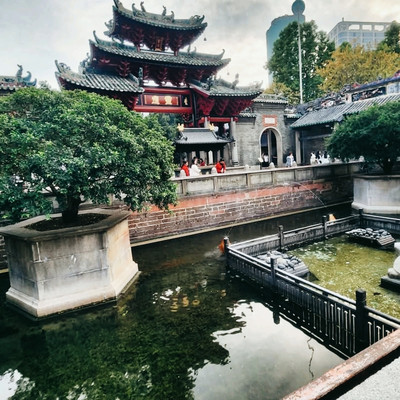
Foshan Ancestral Temple.
Main Highlights: What You Absolutely Can’t Miss
When visiting Foshan Ancestral Temple, also known as Zumiao Temple, you’re stepping into a vibrant tapestry of history, culture, and traditional Chinese architecture. This renowned Taoist temple is not only a spiritual haven but also a treasure trove of visual splendor and cultural significance. Here are the highlights you absolutely cannot miss during your visit:
Impressive Architectural Features
1. Portico and Main Hall:
As you enter the temple complex, the grandeur of the Qian Dian (Portico) and Zheng Dian (Main Hall) will captivate you. These structures are adorned with intricate carvings and elaborate ceiling decorations that showcase the skilled craftsmanship of ancient artisans. The Main Hall, in particular, houses ancient artifacts, including ceremonial weapons and a giant bronze mirror, offering a glimpse into the temple’s storied past.
2. Wan Fu Stage:
Don’t miss the Wan Fu Stage, the most famous ancient theater stage in southern China. Standing six meters high, this stage was originally built for Emperor Beidi to enjoy local dramas. Its unique architectural style and historical significance make it a must-see for any visitor.
Cultural Exhibitions
3. Huang Feihong Memorial and Yip Man Museum:
These two museums are dedicated to the legendary figures of Chinese martial arts. The Huang Feihong Memorial showcases exhibitions related to Huang Feihong, a celebrated martial artist and folk hero. Meanwhile, the Yip Man Museum features a collection of memorabilia from the life of Yip Man, the iconic Wing Chun master. Both venues provide fascinating insights into the martial arts heritage of Foshan.
Traditional Performances
4. Martial Arts and Lion Dance Shows:
Be sure to catch the martial arts demonstrations and lion dance performances held daily at 10:00 AM and 3:00 PM. These vibrant displays not only entertain but also celebrate the rich cultural traditions of the region. Arriving a bit early can help you secure the best seats for these captivating shows.
Scenic Spots and Tranquil Spaces
5. Pond of Scented Brocade:
Take a moment to relax at the Jinxiang Chi (Pond of Scented Brocade), a serene spot within the temple complex. This picturesque pond adds to the tranquil ambiance of the area and is perfect for a reflective pause amid the bustling activities of the temple.
6. Confucius Temple:
Nestled within the complex, the Confucius Temple is another gem worth exploring. This site offers a peaceful retreat and is adorned with beautiful decorations that reflect Confucian values and teachings.
Local Culture and Surroundings
7. Lingnan Tiandi:
After your temple exploration, take a stroll to the nearby Lingnan Tiandi, a pedestrian street filled with charming shops, cafes, and eateries. This vibrant area is perfect for sampling local snacks and enjoying the lively atmosphere of Foshan.
Practical Tips
- Audio Guides: Consider renting an audio guide to enhance your understanding of the temple’s history and significance.
- Entry Tickets: Tickets cost approximately RMB 10 and grant access to multiple attractions within the temple premises, including the museums.
- Best Time to Visit: Weekdays tend to be less crowded, allowing for a more leisurely experience.
With its stunning architecture, rich history, and engaging cultural performances, Foshan Ancestral Temple is an essential stop for any traveler seeking to immerse themselves in the heart of Chinese heritage. Don’t miss out on these highlights that make this temple a true gem in Foshan!
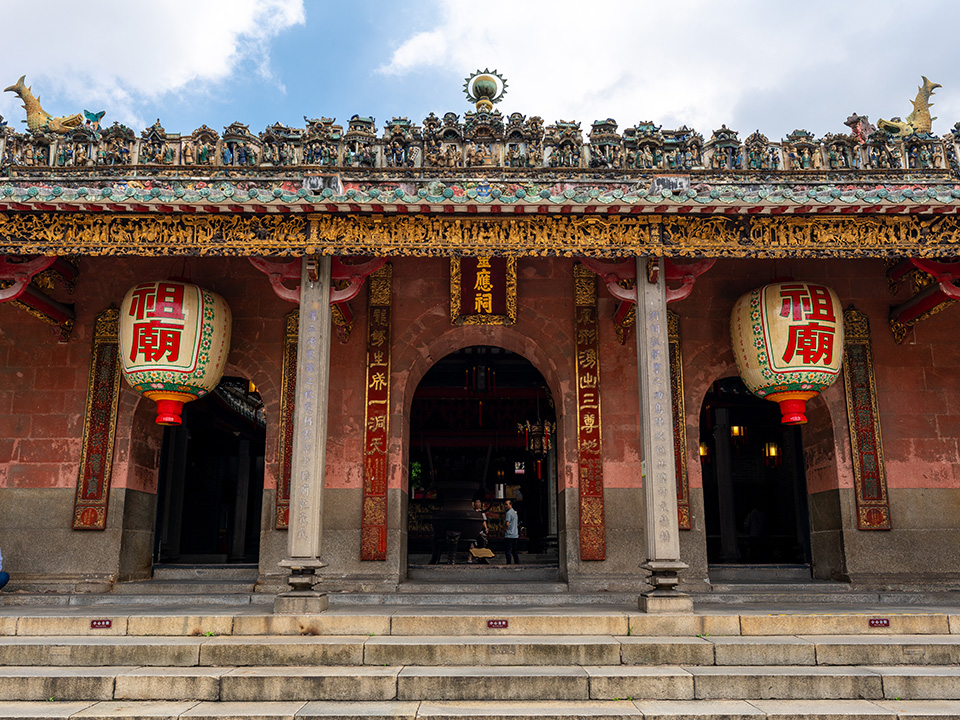
Foshan Ancestral Temple.
Planning Your Visit: A Practical Guide
Visiting the Foshan Ancestral Temple is a remarkable journey into the heart of Chinese culture and history. Whether you’re drawn by the allure of ancient architecture, the vibrancy of martial arts, or simply the chance to explore a significant cultural landmark, this guide will help you navigate your visit effectively.
Getting There
Location:
Foshan Ancestral Temple is centrally located at 21 Zumiao Road, Chancheng District, Foshan, Guangdong Province, China.
Public Transport:
– Bus: A variety of bus routes serve the area, including 101, 105, 106, 110, 116, and more, making it accessible from different parts of the city.
– Subway: If you’re arriving from Guangzhou, take the Guangzhou-Foshan Subway Line to Ancestral Temple Station (祖庙站), which is just a short walk from the temple.
Opening Hours
The temple welcomes visitors daily from 8:30 AM to 6:00 PM. To make the most of your time, consider arriving early to explore the surroundings and enjoy fewer crowds.
Admission Fees
Entry to the temple is approximately RMB 10 per person. Tickets can be purchased at the entrance or through WeChat for convenience. This ticket grants access not only to the temple itself but also to the adjacent museums dedicated to martial arts legends Wong Fei Hung and Yip Man.
What to See
The Foshan Ancestral Temple features several highlights:
- Architectural Marvel: The temple complex spans 3,000 square meters and consists of beautifully preserved structures, including the Main Hall (Zheng Dian), the Festival Hall of Truth (Qingzhen Lou), and the Theatre of a Thousand Good Fortunes (Wanfu Tai).
- Cultural Exhibits: Don’t miss the Huang Feihong Memorial and Yip Man Museum, where you can explore the contributions of these iconic martial artists to Chinese culture.
- Live Performances: Daily martial arts demonstrations and lion dances take place at 10:00 AM and 3:00 PM. It’s advisable to arrive a bit early for the best seats and to soak in the atmosphere.
Tips for an Enjoyable Visit
- Plan Ahead: Weekends and holidays can draw large crowds, so consider visiting on weekdays for a more relaxed experience.
- Audio Guides: For a deeper understanding of the temple’s history and significance, rent an audio guide available on-site.
- Dress Comfortably: Wear comfortable shoes as you’ll be exploring multiple buildings and walking through the complex.
- Photography: The intricate carvings and vibrant colors of the temple make for stunning photographs. Early morning or late afternoon light can create beautiful effects, so plan your visit accordingly.
- Explore the Surroundings: The area around the temple, including Lingnan Tiandi, is perfect for enjoying local snacks and shopping for souvenirs after your visit.
Nearby Attractions
If you have extra time, consider visiting these nearby attractions:
– Liang Garden: A beautiful classical garden showcasing traditional Chinese landscaping.
– Ancient Nanfeng Kiln: Witness the age-old art of pottery in one of the oldest kilns in the region.
– Xiqiao Mountain: A picturesque spot for hiking and enjoying panoramic views of Foshan.
Final Thoughts
A visit to the Foshan Ancestral Temple promises a unique blend of history, culture, and performance art that will enrich your travel experience in China. Whether you’re a history buff, a martial arts enthusiast, or simply seeking a glimpse into local traditions, this temple is not to be missed. Enjoy your journey into the heart of Foshan!
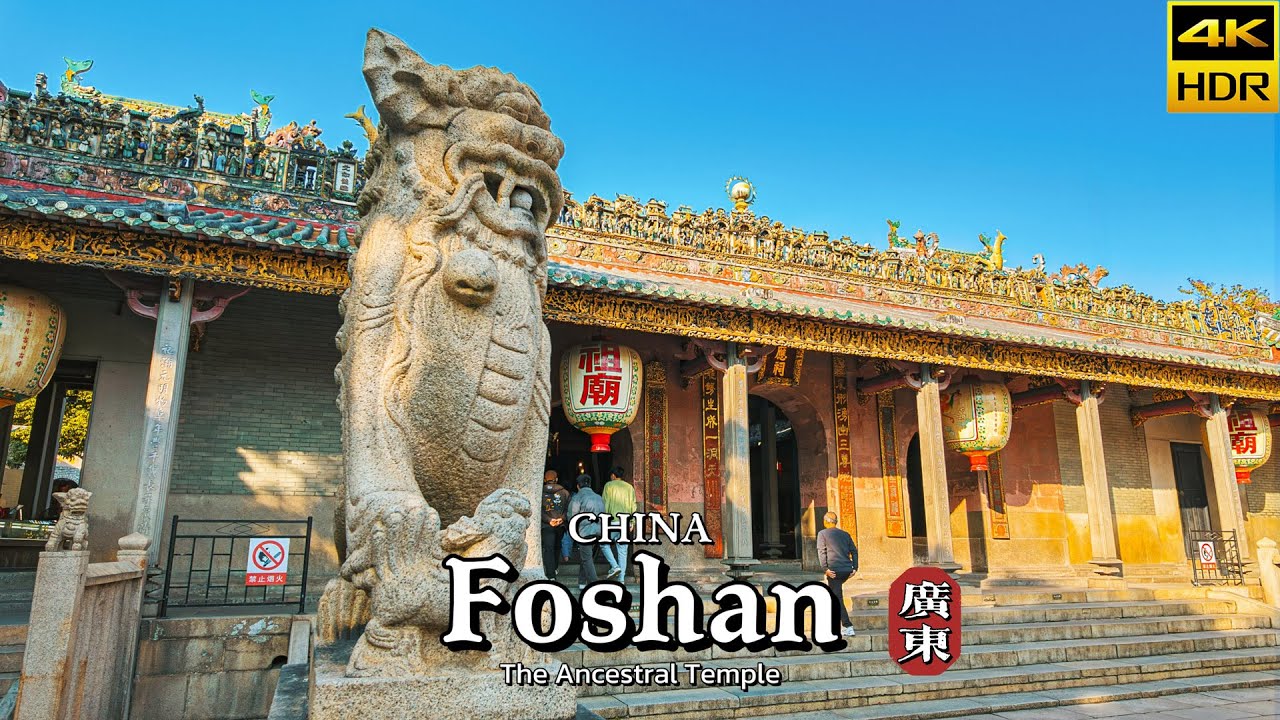
Foshan Ancestral Temple.
Tickets: Prices, Booking, and Tips
Visiting the Foshan Ancestral Temple is a delightful journey into the rich cultural tapestry of southern China. Here’s what you need to know about ticket prices, booking options, and some handy tips to enhance your experience.
Ticket Prices
Admission to the Foshan Ancestral Temple is incredibly affordable, with tickets priced at RMB 10 (approximately $1.50 USD) per person. This ticket grants you access not only to the temple itself but also to the adjacent Wong Fei Hung Memorial Hall and the Yip Man Museum—perfect for martial arts enthusiasts!
Booking Information
Tickets can be purchased on-site at the temple’s entrance. Payment options are convenient, as you can use WeChat Pay, which is widely accepted throughout China. This makes it easy for travelers who prefer cashless transactions. There’s no need for advance booking, but if you’re visiting during peak times or weekends, arriving early is advisable to avoid long lines.
Tips for Your Visit
-
Timing Is Everything: The temple is open daily from 8:30 a.m. to 6:00 p.m. To catch the popular lion dance performances, aim to arrive around 10:00 a.m. or 3:00 p.m. for the best seating.
-
Explore Surroundings: The temple is situated in a vibrant area filled with local eateries and shops. Make a day of it by exploring the nearby Lingnan Tiandi, a pedestrian street perfect for trying local snacks and drinks.
-
Photography: For those keen on photography, consider the lighting conditions at different times of the day. The intricate carvings and architectural details make for stunning photos!
-
Plan for Comfort: The majority of exhibits are air-conditioned, offering a cool respite from the heat, especially during the summer months.
-
Cultural Insight: Don’t miss the opportunity to engage with the martial arts history encapsulated in the museums dedicated to Wong Fei Hung and Yip Man. These figures are central to Chinese martial arts culture and provide a fascinating context to your visit.
By following these tips and being mindful of the ticketing process, your visit to the Foshan Ancestral Temple will surely be a memorable highlight of your travels in China!
How to Get There: A Complete Transportation Guide
Reaching the Foshan Ancestral Temple, also known as Zumiao Temple, is straightforward and convenient, thanks to its central location in Foshan’s bustling Chancheng District. Here’s a comprehensive guide to help you navigate your way there, whether you’re arriving by bus, subway, or taxi.
Getting There by Subway
If you’re traveling from Guangzhou, the most efficient way to reach the temple is via the Guangzhou-Foshan Subway Line. Head to Ancestral Temple Station (祖庙站), which is just a short walk from the temple itself. Once you exit the station, follow the signs, and within minutes, you’ll find yourself at this iconic site.
Arriving by Bus
Foshan boasts a comprehensive bus network, making it easy to reach the Ancestral Temple from various parts of the city. Several bus routes stop nearby, including:
- 101
- 105
- 106
- 107
- 110
- 112
- 116
- 118
- 120
- 124
- 126
- 127
- 128
Check the local bus schedules for the most convenient route from your location. The bus stops are typically well-marked, and announcements are made in Mandarin, so it’s a good idea to have a translation app handy if you’re unsure.
Taking a Taxi or Ride-Hailing Service
For those who prefer a more direct approach, taxis and ride-hailing services like Didi Chuxing are readily available throughout Foshan. Simply provide the driver with the address: 21 Zumiao Road, Chancheng District, Foshan, Guangdong Province, 528011. The journey from various points in Foshan typically takes 10 to 20 minutes, depending on traffic.
Travel Tips
-
Purchase Tickets: Entry to the Ancestral Temple costs approximately RMB 10 per person. Tickets can be purchased at the tourist building nearby, and it’s advisable to arrive early to avoid crowds, especially on weekends.
-
Timing Your Visit: The temple offers martial arts and lion dance shows at 10:00 AM and 3:00 PM daily. Arriving early will secure you a better viewing spot.
-
Language Assistance: Although many signs are in Mandarin, English is commonly spoken in tourist areas. However, having a translation app can enhance your experience, especially when interacting with locals or reading menus at nearby cafes.
-
Exploring the Area: After your visit to the temple, take some time to explore the surrounding area, including Lingnan Tiandi, a charming pedestrian street filled with shops and eateries that reflect the region’s culture.
With this guide, navigating your way to Foshan Ancestral Temple should be both easy and enjoyable. Whether you’re captivated by the intricate architecture, the rich history, or the vibrant performances, your visit to this cultural gem is bound to be memorable. Safe travels!
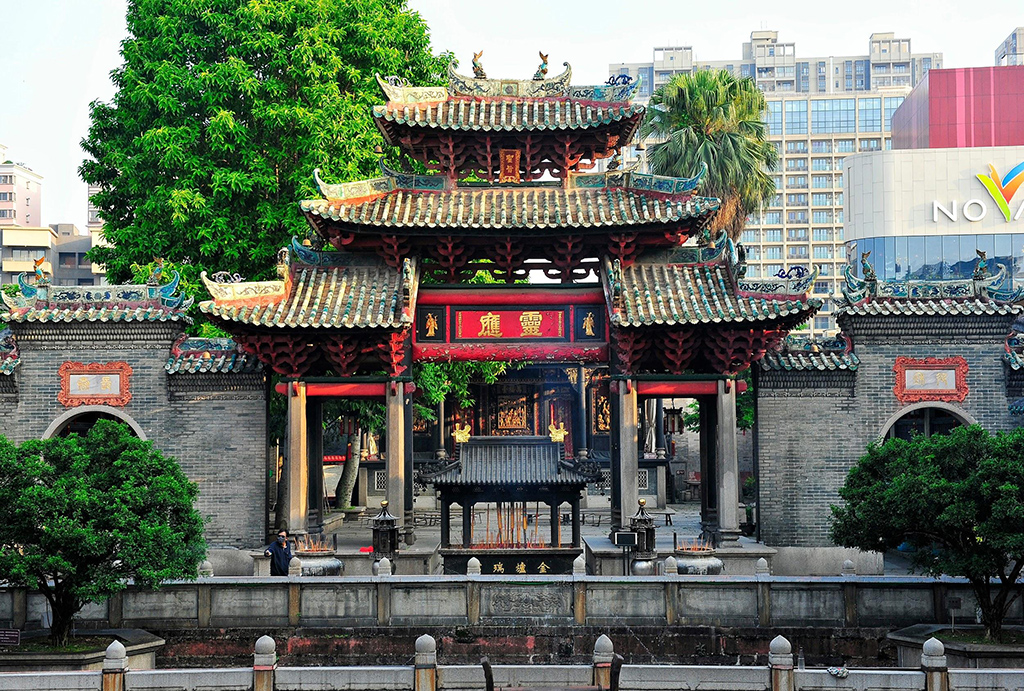
Foshan Ancestral Temple.
Local Cuisine and Accommodation Nearby
Just a stone’s throw away from the stunning Foshan Ancestral Temple, visitors will find a delightful array of local cuisine options and comfortable accommodations that cater to every taste and budget.
Culinary Delights
1. Foshan Street Food
As you explore the vibrant streets surrounding the Ancestral Temple, don’t miss the tantalizing street food stalls. Try local favorites like Danzai Noodles (担仔面), a delicious bowl of noodles served with minced pork and shrimp, or Cha Siu Bao (叉烧包), fluffy steamed buns filled with sweet barbecued pork. These snacks are perfect for a quick bite before heading back to your cultural exploration.
2. Lingnan Tiandi
Located right next to the temple, the Lingnan Tiandi area is a bustling pedestrian street lined with eateries offering traditional Cantonese dishes. For a more sit-down experience, Yuan Wei Restaurant serves authentic Cantonese dim sum, where you can savor delicacies like Shumai and Har Gao while enjoying the charming atmosphere.
3. Zhengwei Restaurant
If you’re in the mood for a hearty meal, head to Zhengwei Restaurant. Known for its Cantonese roast meats, this eatery is a local favorite. Indulge in their succulent roast duck or crispy pork belly, paired with fragrant rice or noodles for a fulfilling dining experience.
Places to Stay
1. Foshan Hotel
For those seeking convenience, the Foshan Hotel offers comfortable accommodations just a short walk from the temple. This well-rated hotel features modern amenities, ensuring a pleasant stay after a day of exploring the cultural sights. Guests appreciate its friendly staff and proximity to local attractions.
2. Hampton by Hilton Foshan
Another excellent option is the Hampton by Hilton Foshan, which blends comfort with affordability. With spacious rooms and a complimentary breakfast, it’s perfect for both solo travelers and families. Plus, its central location makes it easy to access the Ancestral Temple and surrounding areas.
3. Banyan Tree Guangzhou
For a touch of luxury, consider the Banyan Tree Guangzhou, located a bit farther but offering stunning views and top-tier service. This upscale hotel features beautifully designed rooms, a relaxing spa, and exquisite dining options, making it an ideal retreat after a day of sightseeing.
In sum, the area around Foshan Ancestral Temple is a treasure trove of culinary delights and comfortable accommodations, ensuring that your visit is as enjoyable as it is enriching. Whether you’re indulging in local dishes or resting at a nearby hotel, you’ll find plenty to enhance your experience in this vibrant city.
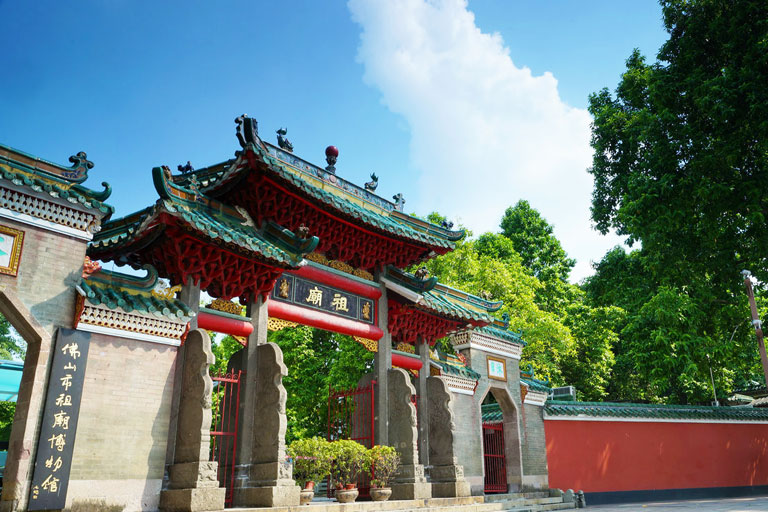
Foshan Ancestral Temple.
Frequently Asked Questions
-
What are the opening hours of Foshan Ancestral Temple?
The temple is open daily from 8:30 a.m. to 6:00 p.m. Make sure to arrive early to enjoy the sights at a leisurely pace! -
How can I get to Foshan Ancestral Temple?
The temple is conveniently located in downtown Foshan. You can take various bus routes, including No. 101, 105, or 124. If you’re coming from Guangzhou, the Guangzhou-Foshan Subway Line will take you to Ancestral Temple Station, just a short walk away. -
Is there an entrance fee to visit the temple?
Yes, there is a nominal entrance fee of RMB 10 per person, which grants you access to the temple and its surrounding attractions, including the Wong Fei Hung and Ip Man museums. -
Are there any performances I should not miss?
Definitely! Be sure to catch the martial arts demonstrations and lion dance performances, which are held daily at 10:00 a.m. and 3:00 p.m. These vibrant displays are a highlight of any visit. -
Can I rent an audio guide while visiting?
Yes, audio guides are available for rent at the temple. They provide valuable insights into the history and significance of the site, enhancing your overall experience. -
What should I expect to see inside the temple complex?
Inside, you’ll find a stunning array of ancient architecture, intricate carvings, and several museums dedicated to famous martial arts masters like Wong Fei Hung and Ip Man. Don’t miss the Wan Fu Stage, an iconic theatre within the temple. -
Is the temple accessible for visitors with mobility issues?
The temple complex features various pathways and structures, but some areas may have stairs or uneven surfaces. It’s advisable for visitors with mobility concerns to check in advance and consider bringing assistance if needed. -
Are there any dining options nearby?
Yes, the area around the Ancestral Temple is bustling with food stalls and restaurants. After exploring the temple, you can enjoy local snacks and dishes in the nearby pedestrian street, making it a perfect spot to relax and refuel.
Final Thoughts on Your Trip
As your journey through Foshan Ancestral Temple comes to a close, take a moment to reflect on the rich tapestry of history, culture, and artistry that envelops this remarkable site. From the intricate carvings that adorn its ancient halls to the vibrant performances of lion dances and martial arts, the temple serves as a living testament to the traditions that have shaped this region for centuries.
Beyond its stunning architecture, the Ancestral Temple offers a unique glimpse into the heart of Foshan’s identity, connecting you to the legends of martial arts masters like Wong Fei Hung and Ip Man. Whether you marveled at the ornate details of the main hall or felt the thrill of a live Kung Fu demonstration, each experience is a thread woven into the larger story of this extraordinary place.
As you step back into the bustling streets of Foshan, carry with you the echoes of clashing swords and the spirit of the ancestors who once worshipped here. This is not just a visit; it’s a journey into the soul of a city that embraces its past while looking forward to a vibrant future. May your memories of the Ancestral Temple inspire you to continue exploring the rich cultural heritage that China has to offer. Safe travels!